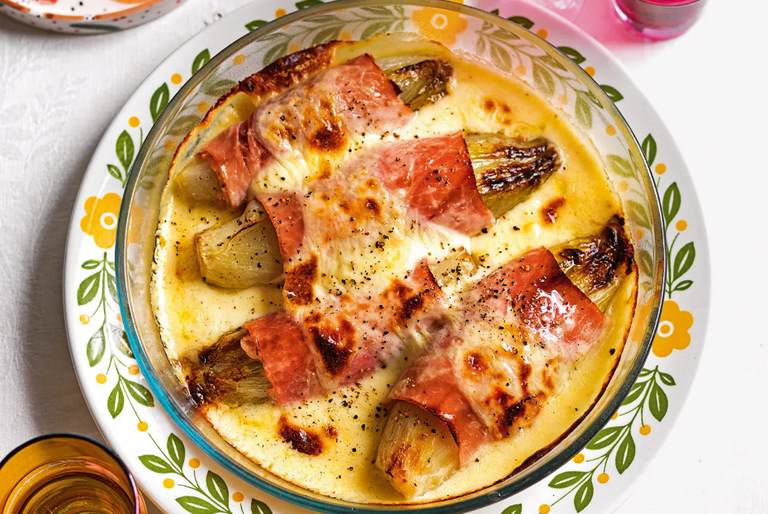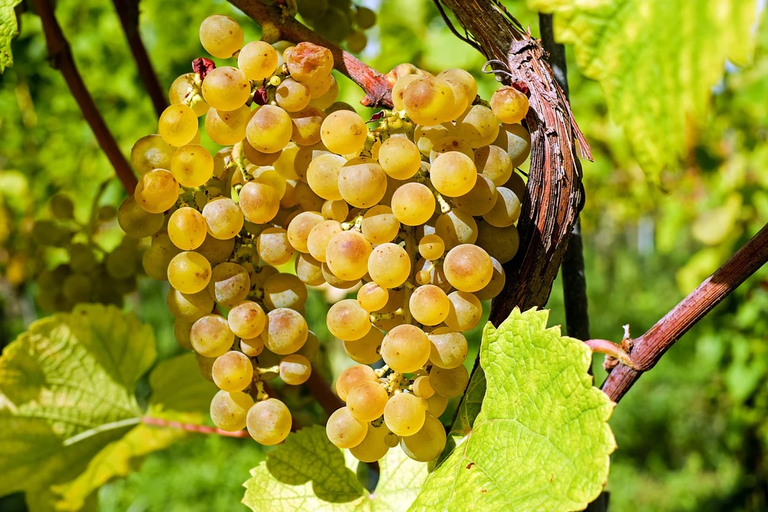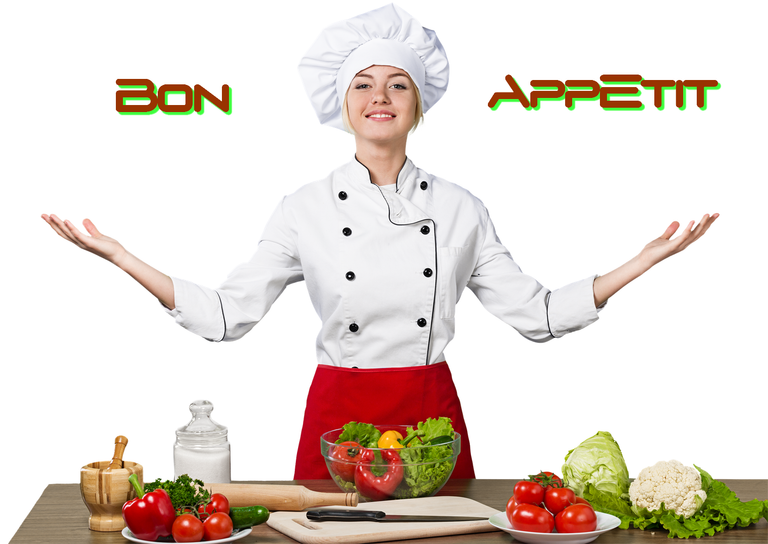
La endibia o escarola belga tiene la forma de un torpedo y crece a unos 14 cm. de largo. Tiene hojas blancas tiernas con bordes de hoja amarillos o rojos. Las hojas ofrecen una textura suave y un crujido delicado con un agradable sabor amargo. Su primera aparición fue en 1830 y se debe a un granjero belga que cosechaba achicoria. En una ocasión, al guardar las semillas en el sótano para secarlas y usarlas como un substituto de café, se dio cuenta que las raíces habían brotado unas pequeñas hojas blancas, tiernas y ligeramente amargas. Es así que el día de hoy, su cultivo se hace alejado de la luz del sol, lo que previene que las hojas se abran y se descoloren. Entre más blanca sea la hoja de la endivia, menor será su sabor amargo.

Endive or Belgian endive has the shape of a torpedo and grows to about 14 cm. long. It has tender white leaves with yellow or red leaf edges. The leaves offer a soft texture and delicate crunch with a pleasant bitter taste. Its first appearance was in 1830 and is due to a Belgian farmer who harvested chicory. On one occasion, while saving the seeds in the basement to dry them and use them as a coffee substitute, he noticed that the roots had sprouted small, tender, slightly bitter white leaves. Thus, today, its cultivation is done away from sunlight, which prevents the leaves from opening and discoloring. The whiter the endive leaf, the less bitter its taste will be.
Receta para personas n. 4 / Recipe for people no. 4
Nota: 342 calorías por persona / Note: 342 calories per person
Ingredientes
Para las tartaletas:
125 g de harina blanca "00"
85 g de mantequilla
2 cucharadas de agua
sal
Para el relleno:
2 cabezas de escarola
2 huevos
1 vaso de leche
1 cucharada de fécula 1/2 diente de ajo
2 nueces de mantequilla , sal y pimienta
Para decorar:
80 g de jamón crudo

For the tartlets:
125 g white flour "00"
85g butter
2 tablespoons of water
salt
For the filling:
2 heads of endive
2 eggs
1 glass of milk
1 tablespoon of starch 1/2 clove of garlic
2 nuts of butter, salt and pepper
To decorate:
80 g raw ham
Preparación
(35') + 20' Cocción
- Preparar la masa con la harina, la mantequilla blanda, la sal y el agua, mezclando los ingredientes rápidamente.
- Cuando la masa esté suave formamos una bola, la envolvemos en film transparente y la dejamos reposar en el frigorífico.
- Escaldamos la escarola en agua y sal, la escurrimos y la secamos con un paño.
- Derrita la mantequilla en una cacerola y dore 1/2 diente de ajo; Retírela y cocine la escarola con sal y pimienta durante 5 minutos.
- En un bol combinar los huevos con la leche, el almidón, una pizca de sal y batir bien.
- Sacar la masa del frigorífico y extenderla con un rodillo hasta conseguir un grosor de 1/2 cm.
- Recorta 4 discos con un diámetro de aproximadamente 12 cm; Enmantequilla y enharina 4 moldes de una sola porción y forralos con la masa.
- Pincha la pasta con un tenedor, añade la escarola estofada y cúbrela con la mezcla de huevo.
- Llevar al horno precalentado a 180°C durante 20 minutos.
- En cuanto las tartas estén listas, las desmoldamos y colocamos 2-3 lonchas finas de jamón crudo encima de cada una.

(35') + 20' Cooking
- Prepare the dough with the flour, softened butter, salt and water, mixing the ingredients quickly.
- When the dough is soft, we form a ball, wrap it in transparent film and let it rest in the refrigerator.
- We blanch the endive in water and salt, drain it and dry it with a cloth.
- Melt butter in a saucepan and brown 1/2 clove garlic; Remove and cook escarole with salt and pepper for 5 minutes.
- In a bowl, combine the eggs with the milk, starch, a pinch of salt and beat well.
- Take the dough out of the refrigerator and roll it out with a rolling pin until it is 1/2 cm thick.
- Cut out 4 discs with a diameter of approximately 12 cm; Butter and flour 4 single-serving molds and line them with the dough.
- Prick the pasta with a fork, add the stewed endive, and coat with the egg mixture.
- Bake in a preheated oven at 180°C for 20 minutes.
- As soon as the pies are ready, we unmold them and place 2-3 thin slices of raw ham on top of each one.
Vino recomendado para esta receta: Tocai Friulano. / Recommended wine for this recipe: Tocai Friulano.
Hasta hace unos años, el vino friulano se llamaba Tocai. Algunos acuerdos entre Italia y la Unión Europea de 1993 prohibieron el uso del nombre "Tocai" a partir de marzo de 2007, por ser demasiado similar al nombre húngaro Tokaj y a la zona de producción del mismo nombre. La similitud está relacionada única y exclusivamente con el nombre, ya que el Tocai Friulano y el Tokaj Hungarese son vinos completamente diferentes en cuanto a color, aroma, sabor y métodos de producción, además el Tokaj húngaro no es un solo vino, sino varios vinos procedentes de la misma zona de la ciudad de Tokaj.
En enero de 2008, la región Friuli-Venezia Giulia todavía estaba presentando un nuevo recurso para que se anulara la sentencia. El 15 de noviembre de 2008, el Tribunal Constitucional declaró inconstitucional la ley regional de Friuli - Venezia Giulia 24/2007 que establecía la posibilidad de utilizar el nombre Tocai para las ventas en territorio italiano. Desde la cosecha de 2008, no está permitido utilizar el nombre Tocai en las etiquetas. Entre las alquimias burocráticas en las que se han centrado algunos estudiosos, también se ha examinado la cuestión de si, dado el actual estatus regulatorio, verter vino blanco "Friulano" en una jarra marcada "Tocai" constituye o no un acto ilícito. Por el momento la discusión se encuentra todavía en la fase preliminar de desambiguación.
Para completar, en el libro editado por Walter Filiputti publicado por FRIULI VENEZIA GIULIA VIA DEI SAPORI EDITORE también es posible leer absolutamente correctamente en la página. 21 que: "En cualquier taberna digna de ese nombre entras en Friuli y pides un "tajut" blanco, que será Tocai...". Desgraciadamente, aunque sin darse cuenta, los decretos adoptados significan que, además de Tocai, en Friuli están prohibidos "Tai y tajut", como se desprende de la legislación europea que reserva absolutamente el nombre Tai -y sus variantes- sólo a "fu Tocai" originario del Véneto. Los decretos establecen, en otras palabras, que cualquier " Tai " y todas las variaciones imaginativas sólo pueden indicar el Tocai Veneto. En este sentido se aplica la normativa europea relativa a las indicaciones DOP e IGP.
Origen de la variedad de uva.
El libro «Vitti di Toccai...300» de Stefano Cosma y Cristina Burcheri, Edizioni della Laguna, relata el contrato matrimonial de Aurora Formentini cuando se casó con el conde húngaro Adam Batthyany en 1632. Entre los diversos bienes aportados como dote por el antepasado de En los condes de San Floriano del Collio también hay «300 vitti di Toccai» ya cultivados en la época en la campiña de Mossa y San Lorenzo Isontino. Esto demuestra el origen italiano de la variedad de uva Tocai.

Until a few years ago, Friulian wine was called Tocai. Some agreements between Italy and the European Union in 1993 prohibited the use of the name "Tocai" as of March 2007, for being too similar to the Hungarian name Tokaj and the production area of the same name. The similarity is related solely and exclusively to the name, since Tocai Friulano and Tokaj Hungarese are completely different wines in terms of color, aroma, flavor and production methods, and Hungarian Tokaj is not a single wine, but several wines. coming from the same area of the city of Tokaj.
In January 2008, the Friuli-Venezia Giulia region was still filing a new appeal to have the sentence overturned. On November 15, 2008, the Constitutional Court declared unconstitutional the regional law of Friuli - Venezia Giulia 24/2007 that established the possibility of using the Tocai name for sales on Italian territory. Since the 2008 harvest, it is not allowed to use the name Tocai on labels. Among the bureaucratic alchemies that some scholars have focused on, the question of whether or not, given the current regulatory status, pouring "Friulano" white wine into a jug marked "Tocai" constitutes an illicit act has also been examined. At the moment the discussion is still in the preliminary disambiguation phase.
To complete, in the book edited by Walter Filiputti published by FRIULI VENEZIA GIULIA VIA DEI SAPORI EDITORE it is also possible to read absolutely correctly on the page. 21 that: "In any tavern worthy of the name you enter Friuli and ask for a white "tajut", which will be Tocai...". Unfortunately, although inadvertently, the decrees adopted mean that, in addition to Tocai, in Friuli "Tai and tajut" are prohibited, as can be seen from European legislation that absolutely reserves the name Tai - and its variants - only to "fu Tocai "originally from Veneto. The decrees establish, in other words, that any "Tai" and all imaginative variations can only indicate the Tocai Veneto. In this sense, the European regulations regarding DOP and PGI indications apply.
Origin of the grape variety.
The book "Vitti di Toccai...300" by Stefano Cosma and Cristina Burcheri, Edizioni della Laguna, recounts the marriage contract of Aurora Formentini when she married the Hungarian count Adam Batthyany in 1632. Among the various assets provided as dowry by him ancestor of In the counts of San Floriano del Collio there are also “300 vitti di Toccai” already cultivated at the time in the countryside of Mossa and San Lorenzo Isontino. This demonstrates the Italian origin of the grape variety.

Fuente imagen inicial . / Source initial image: La Cucina Italiana.
Fuente imagen final. / Source final image: GimmeWine.
Estas recetas y tantas otras publicadas en #BLURT las pueden encontrar en mis blogs en italiano, inglés y español. Más de 5.000 recetas para darle fantasía y color a tu mesa y hacer una figura digna de un/a chefs con tus invitados.
These recipes and many others published in # BLURT can be found on my blogs in Italian, English and Spanish. More than 5,000 recipes to give fantasy and color to your table and make a figure worthy of a chef with your guests.
Y como siempre me despido de todos con un:
And as always I bid you all farewell with a:

Mis Blogs y Sitios Web / My Blogs & Websites:
I decided to open this blog to share with others the passion I have for cooking, hence the title of the blog, there will be no shortage of classic recipes, revisited, personal and try to cover as much as possible. The recipes that you will find reflect my daily life, I hope to be able, despite my modest experience, to serve you with my advice, because whatever you decide to do, cooking requires time, love and passion.
Decidí abrir este blog para compartir con otras personas la pasión que tengo por la cocina, de ahí el título del blog, no faltarán recetas clásicas, revisitadas, personales e intentaré abarcar lo máximo posible. Las recetas que encontrarás reflejan mi vida diaria, espero poder, a pesar de mi modesta experiencia, poder servirte en mis consejos, porque decidas lo que decidas hacer, cocinar requiere tiempo, amor y pasión.

Upvoted. Thank You for sending some of your rewards to @null. Read my last posts to make sure that BLURT burning is profitable for you. Before using this bot please make sure your account has at least 100 BP. Get more BLURT:
@ mariuszkarowski/how-to-get-automatic-upvote-from-my-accounts@ blurtbooster/blurt-booster-introduction-rules-and-guidelines-1699999662965@ nalexadre/blurt-nexus-creating-an-affiliate-account-1700008765859@ kryptodenno - win BLURT POWER delegationNote: This bot will not vote on AI-generated content
Thanks!